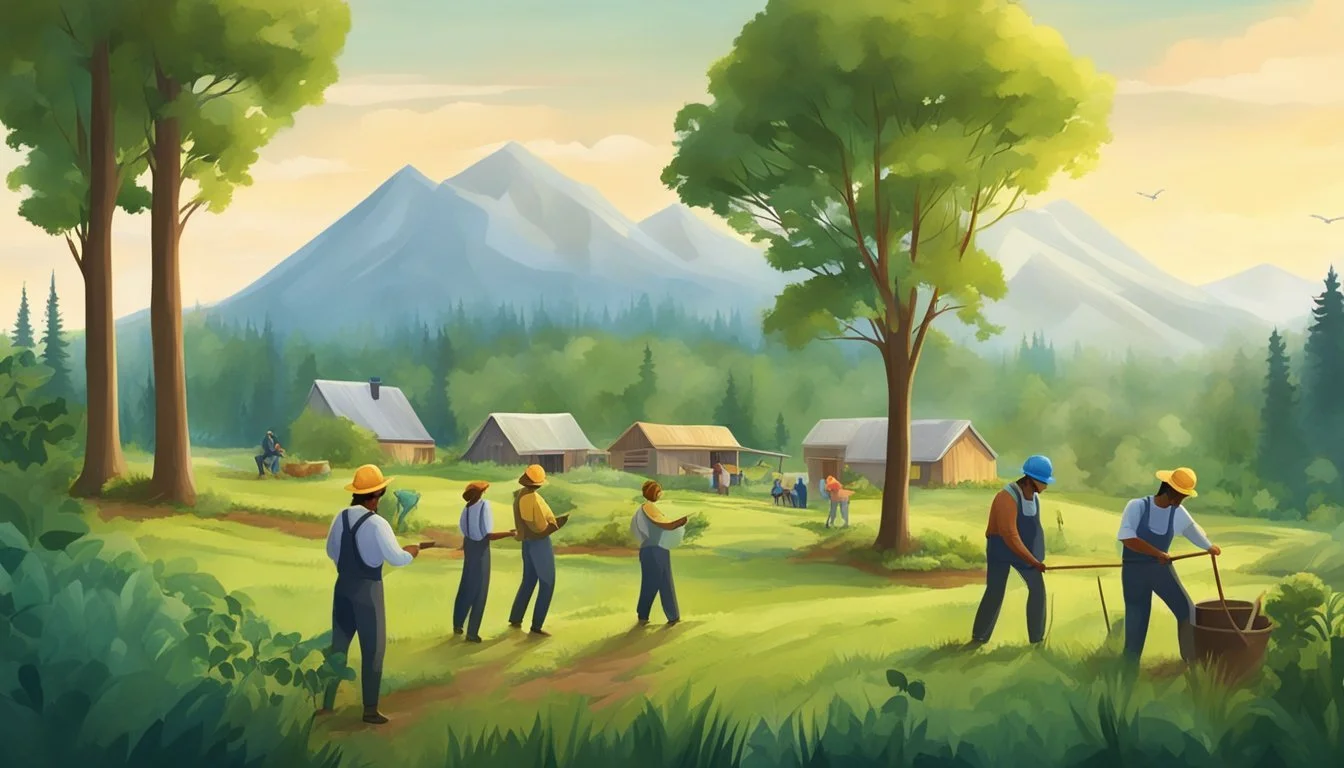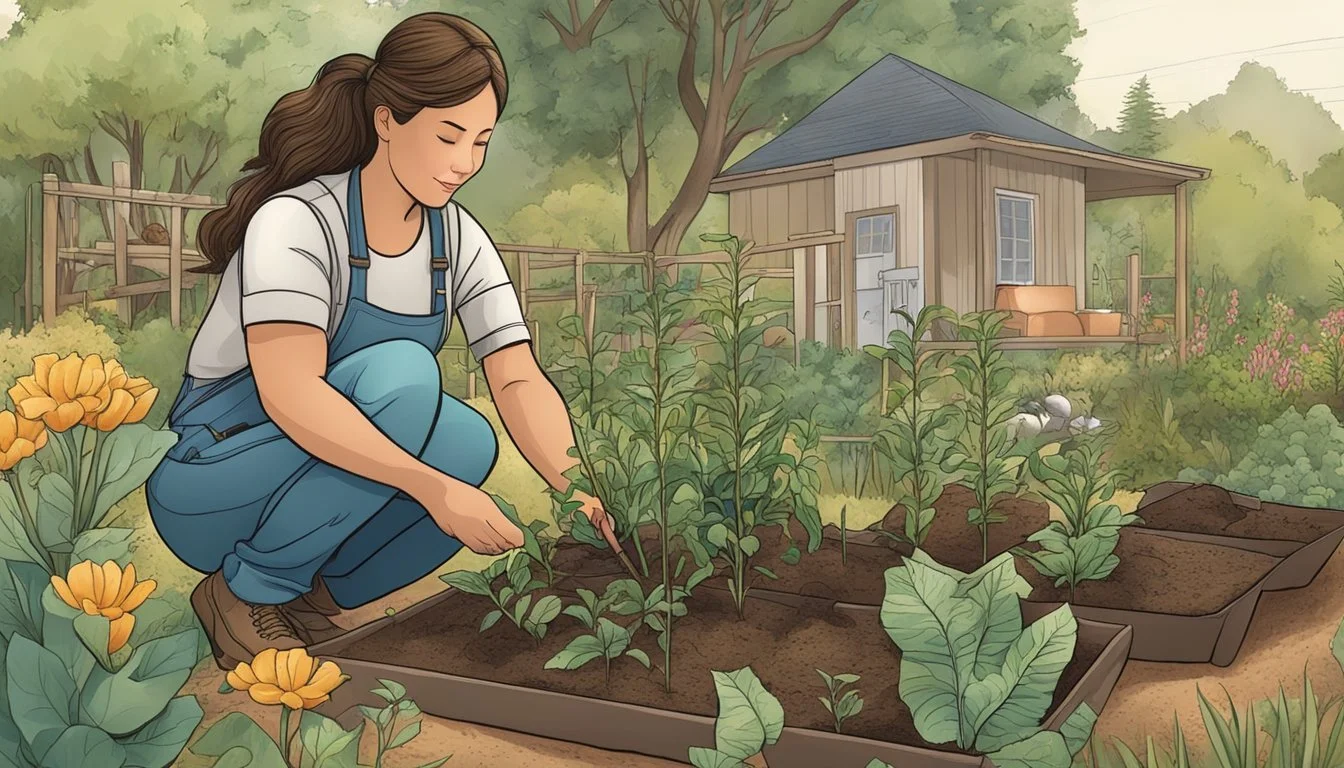The Role of Homesteads in Conservation Efforts
A Sustainable Approach
Homesteads play a crucial role in modern conservation efforts, often bridging the gap between human activity and the natural environment. These small-scale, family-oriented plots of land offer a unique opportunity for individuals and communities to contribute actively to biodiversity conservation and sustainable land management. Through the practice of homestead agroforestry, landowners can enhance the resilience of local ecosystems, supporting a diverse array of plant and animal species.
The concept of conservation within homesteads extends beyond traditional farming practices. It encompasses a holistic approach to land management that considers the long-term health of the environment. Homesteads integrate agricultural productivity with conservation goals, creating a symbiotic relationship between the land and its stewards. Landowners who adopt such methods demonstrate that personal and local actions are significant in the broader context of environmental preservation and can help mitigate the impacts of climate change.
As pillars in conservation strategies, homesteads can adapt and mitigate the effects of climate change by cultivating plant varieties resilient to changing conditions and managing land in a way that sequesters carbon. The involvement of local communities and indigenous knowledge is often pivotal in developing these sustainable practices, enriching conservation efforts with a depth of experience rooted in a connection to the land. Through these individual and communal actions, homesteads are redefining the narrative of conservation, showing that effective environmental stewardship can start at home.
The Importance of Biodiversity
Biodiversity, encompassing the full variety of life, is fundamental to the health of our planet. Homesteads play a pivotal role in maintaining this diversity through various conservation methods.
Defining Biodiversity
Biodiversity, or biological diversity, is the term used to describe the variety of life on Earth. It reflects the number, variety, and variability of living organisms and includes diversity within species (genetic diversity), between species (species diversity), and between ecosystems. The three levels of biodiversity ensure natural sustainability for all life forms.
Benefits of Biodiversity
Ecosystem Services: Biodiversity is critical for the functioning of ecosystems which provide essential services such as food production, climate regulation, and water purification. For example, forests and wetlands not only serve as habitats for a wide range of species but also contribute to water and air purification.
Economic Benefits: A diverse set of species ensures natural sustainability for all life forms, which is foundational to sectors such as agriculture, cosmetics, pharmaceuticals, and more. Genetic diversity within crops can prevent diseases that might wipe out single-crop fields.
Cultural and Aesthetic Value: Biodiversity also has immense cultural and aesthetic importance. Many societies place high value on the variety of plants and animals that can be found in nature for their contributions to identity, including recreational and spiritual well-being.
Threats to Biodiversity
Habitat Loss: Land development for agriculture, housing, and industry is one of the biggest threats to biodiversity, as it can lead to the degradation or destruction of crucial habitats.
Climate Change: Changes in climate patterns affect weather systems, oceanic processes, and habitat ranges, placing many species at risk of extinction.
Pollution: The spread of pollutants in the environment can poison ecosystems, harming both genetic and species diversity.
Overexploitation: This refers to harvesting species from the wild at rates faster than natural populations can recover. Unsustainable fishing, hunting, and logging practices are direct threats to species diversity.
Conservation Basics
Conservation efforts are essential to maintain biodiversity, protect species, and ensure the continuation of our planet's ecosystems. These initiatives range from individual actions to global programs, all aimed at preserving the natural world for future generations.
Conservation Goals
The primary objective of biodiversity conservation is to protect species from extinction, maintain ecosystem vitality, and preserve genetic diversity. Conservation measures are implemented to restore habitats, prevent the overexploitation of natural resources, and mitigate the negative impacts of human activities. By focusing on conservation goals, strategies are developed that not only protect individual species but also safeguard entire ecosystems and the services they provide.
In Situ vs. Ex Situ Conservation
In situ conservation involves protecting species within their natural habitats. It is the cornerstone of conserving biodiversity as it maintains the complex interplay between species and their environments. This approach includes the establishment of protected areas such as national parks and wildlife reserves.
In situ conservation tactics:
Establishing protected areas
Ecological restoration projects
Ex situ conservation, on the other hand, involves the preservation of species outside their natural habitats. This is often employed for critically endangered species that cannot currently be protected in the wild.
Ex situ conservation methods:
Captive breeding programs
Botanical gardens
Seed banks
Both in situ and ex situ conservation are critical. They complement each other, ensuring that conservationists can respond flexibly to varying threats against biodiversity.
Homesteads in Conservation
Homestead gardens play a multifaceted role in ecological conservation. They serve as a bulwark for biodiversity, contribute to food security, and support essential ecosystem services.
Roles and Benefits of Homesteads
Homesteads provide important ecosystem services by maintaining biodiversity and supporting the conservation of various plant and animal species. Home gardens are often rich in species diversity, including vegetables, heritage crops, medicinal plants, and even livestock. This diversity ensures habitat conservation and fosters food security, especially in rural areas.
Habitat: Diverse homestead gardens create microhabitats that act as refuge for local wildlife and beneficial insects.
Biodiversity: They conserve a wide range of plant species, including traditional and indigenous varieties that might be rare or endangered.
Livestock: Integration of animals provides a closed-loop system, enhancing soil fertility and reducing waste.
Food Security: By growing their own food, homesteads contribute to local and personal food supplies, thus enhancing resilience to food shortages.
Furthermore, homestead gardens can help mitigate climate change impacts by sequestering carbon in vegetation and soil.
Sustainable Practices on Homesteads
Sustainability on homesteads is achieved through various practices that manage resources efficiently and with a long-term perspective. The management and conservation strategies implemented ensure that homestead gardens produce maximum yield with minimal ecological footprint. These strategies include:
Energy Conservation: Use of renewable energy sources and energy-efficient technologies for daily operations.
Soil Health: Utilization of composting and organic fertilizers to maintain soil fertility and structure.
Water: Implementation of rainwater harvesting and drip irrigation systems to optimize water use.
Homestead gardens are recognized as one of the oldest traditional land-use systems and a cornerstone of sustainability. They not only conserve biodiversity but also embody sustainable agricultural practices that contribute to livelihoods and ecological balance.
Climate Change and Homesteads
The interface between homesteads and climate change is marked by the potential of these domiciles to adapt to and mitigate the effects of a changing climate. Through thoughtful management, homesteads can become resilient spaces of carbon sequestration and storage, helping to reduce atmospheric carbon dioxide levels.
Adapting Homesteads to Climate Change
Adaptation strategies for homesteads in the face of climate change involve both infrastructural and ecological adjustments. For instance, planting climate-resilient vegetation can guard against soil erosion and create microclimates that reduce local temperature extremes. On the structural side, enhancing insulation and developing rainwater harvesting systems can increase homestead resilience and decrease dependency on external resources.
Structural Adjustments:
Improved insulation
Water-efficient systems
Weather-resistant construction materials
Ecological Adjustments:
Drought-tolerant plants
Soil erosion control measures
Creation of biodiversity supports
Homesteads as Carbon Sinks
Homesteads can actively contribute to climate change mitigation through carbon sequestration. The establishment of homestead forests, for example, serves as a direct method of carbon storage as trees absorb carbon dioxide from the atmosphere. Techniques such as composting and permaculture can turn homesteads into effective carbon sinks, helping to offset greenhouse gas emissions.
Carbon Sequestration Techniques:
Tree Planting: Diverse species can capture CO2 effectively.
Soil Management: Enriching soil organic matter to enhance its carbon holding capacity.
Permaculture Practices: Implementing sustainable agricultural practices that mimic natural ecosystems.
Community and Collaboration
In the realm of conservation, the amalgamation of traditional wisdom and cooperative efforts stands as a cornerstone for sustainable practices. Community involvement and collaboration are pivotal for integrating indigenous knowledge with modern conservation techniques, ensuring the protection of natural resources through inclusive decision-making.
Indigenous Knowledge and Practices
Indigenous people possess a profound connection with their environment, fostered over centuries. They have developed a wealth of knowledge regarding the ecology of their land and the sustainable management of its resources. Utilizing their traditional practices and local rules, they contribute significantly to conservation by maintaining biodiversity and enhancing the resilience of ecosystems. For instance, certain communities implement rotational farming, which allows periods of land recovery, and taboos that regulate resource use to prevent over-exploitation.
Engaging Local Communities
The engagement of community members in conservation efforts is crucial as it fosters ownership and responsibility for the outcomes. In collaborative initiatives, every stakeholder, from local inhabitants to conservation agencies, participates in decision-making processes. This involvement ensures that community needs are met while maintaining ecological integrity. Recognizing the value of traditional knowledge held by local communities, conservationists often propose projects that incorporate indigenous methods with contemporary strategies, which can lead to more successful and sustainable conservation practices.
Conservation Strategies
Conservation strategies play a pivotal role in safeguarding the planet's biodiversity and natural resources. They encompass a wide range of tools and agreements that aim to protect, preserve, and sustainably manage wildlife and ecosystems.
Biodiversity Frameworks and Policies
In the realm of conservation, biodiversity frameworks and policies serve as foundational blueprints for nations and organizations to follow. For instance, the post-2020 global biodiversity framework is a stepping-stone towards rectifying the biodiversity crisis. It sets out to replace the Aichi Targets, with the ambition to guide international efforts through coordinated actions, delineated goals, and defined targets. These policies are critical instruments for shaping the actions of governments, NGOs, and civil society in the conservation of biodiversity.
Protected Areas and Wildlife Reserves
Protected areas and wildlife reserves are crucial sanctuaries for the preservation of species and ecosystems. These areas function as safe havens where conservation measures can be implemented effectively to protect wildlife and habitats. Designating land and sea regions as protected can mitigate threats such as habitat degradation, wildlife exploitation, and other environmental challenges. Here's how these areas contribute to conservation goals:
Area Conservation: By the establishment and expansion of protected regions, we see a direct positive impact on nature's diversity as emphasized in an article from Nature.
Local Communities: Successful conservation often relies on the integration of local communities as stated by ECOLIFE Conservation, highlighting the importance of collaborative decision-making.
Governance Efficiency: Effective governance of protected areas is synonymous with enhanced conservation performance, fostering biodiversity and safeguarding natural resources. This perspective is underscored by research from Springer.
Across the globe, the stewardship and management of these regions by governments, NGOs, and local stakeholders are indispensable for achieving the objectives of the Convention on Biological Diversity and furthering the cause of environmental conservation.
Challenges and Solutions
Conservation efforts on homesteads face significant hurdles, yet innovative approaches and collaborative partnerships hold the potential for turning challenges into successes.
Overcoming Deforestation and Habitat Loss
Deforestation and habitat loss are two of the most pressing issues facing homestead conservation. Private entities play a crucial role, as they often control large swaths of land that can be strategically managed for conservation. Efficient use of resourcing is key, as is engaging landowners in the importance of preserving their land. Innovative partnerships, like those seen in the Midwest where land trusts are tackling legislative challenges, demonstrate how collaboration can lead to preserving habitats.
Addressing Biodiversity and Conservation Funding
Biodiversity loss is directly linked to the degradation of habitats. Securing sufficient conservation funding is challenging; yet, it's essential for implementing effective conservation strategies. Private entities, alongside public organizations, can help finance conservation initiatives aimed at protecting threatened species. Homesteads represent an opportunity to contribute to biodiversity conservation, not only through funding but also through the stewardship of various habitats.
The Role of Women in Conservation
Women play an instrumental role in shaping conservation outcomes. Their participation brings diverse perspectives and approaches to environmental stewardship, while addressing equity and aiming to overcome discrimination.
Women’s Participation in Stewardship
Women around the world are key stewards of biological diversity and natural resources. They contribute significantly to conservation through both direct and indirect actions. In many rural communities, women manage crucial aspects of biodiversity, such as seed selection and agrobiodiversity. They make up a substantial part of the workforce in agriculture and often hold traditional ecological knowledge that is vital for the sustainable management of resources.
The inclusion of women in conservation initiatives is not just about equality; it affects the effectiveness and longevity of conservation actions. Studies, such as those referred to in JSTOR Daily, highlight the significance of women's involvement for successful conservation efforts. Moreover, when women have decision-making power in conservation, diverse perspectives can lead to more holistic and sustainable environmental management strategies.
Combating Discrimination in Conservation Fields
Despite their critical contributions, women frequently face systemic barriers that limit their participation in conservation fields. Discrimination manifests in a variety of ways, from unequal access to education and resources to underrepresentation in leadership roles within conservation organizations.
Initiatives to enhance women's roles in biodiversity conservation highlight the necessity to combat gender biases and ensure equity. Organizations like The Nature Conservancy are actively working to involve women in making key conservation decisions that impact their communities. Ensuring women have a seat at the table leads to more inclusive and effective approaches to resource management and reaffirms the fundamental principle that conservation is most successful when it reflects the contributions and needs of the entire population.
The Global Context
The global approach to conservation is multifaceted, involving international agreements, trade networks, and a range of environmental and socioeconomic factors. These efforts are influenced by and respond to the pressures of climate change, the demand for commodities like timber and crops, and the essential role of frontline communities in preserving biodiversity.
International Agreements and Conservation
International agreements play a critical role in setting targets and creating frameworks for nature conservation. Initiatives such as the Convention on Biological Diversity set the global stage for protected area governance and emphasize area-based conservation. Under these agreements, countries commit to conserve important ecological regions to combat global warming and climate change, acknowledging the necessity to maintain forest cover and protect the habitats of countless species. One key outcome is the recognition of the importance of sustainable practices that support both nature conservation and the livelihood of frontline communities.
Trade Networks and Biodiversity
The global trade networks of crops, fruit, and timber are linked intricately to biodiversity loss and conservation successes. Agricultural expansion for these commodities often results in habitat destruction, but sustainable trade practices can provide solutions. Equitable trade can alleviate poverty and foster stewardship, ensuring that local communities benefit from conservation actions. This is particularly relevant in the context of the One Earth vision, which seeks to balance human needs with the imperative to preserve nature's diversity. With well-managed trade networks, the goal is to support thriving ecosystems while also nurturing human well-being.
Future Directions
The emerging strategies in conservation are defined by the promise of technology and international cooperation. These approaches aim to address critical challenges such as climate change, biodiversity loss, and crisis management.
Technological Innovations in Conservation
Technological advancements offer powerful tools for climate change adaptation and the fight against mass extinction. For instance, innovative carbon capture technologies are enhancing the efficiency of carbon sinks, vital in reducing atmospheric CO2 levels. Similarly, genetic research is being leveraged to bolster disease resistance in vulnerable species, potentially reducing the impact of disease outbreaks on biodiversity.
Drones and remote sensing technologies are also becoming indispensable in monitoring wildlife habitats and curtailing poaching activities. They provide real-time data which is crucial for swift conservation action. A new future for conservation involves not only adopting these technologies but also continuously evolving them to meet changing environmental conditions.
Global Strategies and Crisis Response
A united global front is essential for effective conservation, particularly in response to ecological crises. Strategies are currently shifting towards greater international collaboration, with agreements that prioritize both climate change adaptation and the mitigation of a burgeoning mass extinction crisis. A diverse but united conservation movement understands the complexities of environmental threats and the need for coherent global action plans.
Moreover, as climate-related disasters escalate, the field of conservation is looking into potential frameworks for managed retreat. This is not just a crisis response, but a proactive step to revitalize regions and make better use of environmental resources. For example, rural areas in decline could be reimagined as conservation spaces that facilitate ecological restoration while also boosting local economies. Understanding managed retreat strategies could provide new insights into successful conservation efforts amidst changing global conditions.










